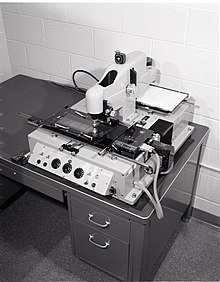Microdensitometer

A microdensitometer is an optical instrument used to measure optical densities in the microscopic domain.[1][2][3] A well-known microdensitometer, used in the photographic industry, is a granularity instrument or granularity machine.[2] The granularity measurement[2] involves the use of an optical aperture, 10-50 micrometers in diameter, and in the recording of thousands of optical density readings. The standard deviation of this series of measurements is known as the granularity[2][3] of the measured transmission surface, optical film, or photographic film, in particular .
An alternative version to the traditional point-by-point microdensitometer is the beam expanded laser microdensitometer.[3][4] This instrument can illuminate simultaneously an area a few centimeters wide with an ultra thin height, in the micrometer regime.[4] Advantages include increased depth of focus, significant increases in data collection speed, and superior signal to noise ratios.[3][4] In microscopy applications, this type of ultra thin beam-expanded illumination can also be known as light sheet illumination or selective plane illumination.
This measurement technique, using ultra-thin expanded laser beams, is particularly useful to detect microscopic imperfections in optical coatings or transmission optical surfaces.[5]
See also
References
- ^ J. C. Dainty and R. Shaw, Image Science (Academic, New york, 1974).
- ^ a b c d T. H. James, The Theory of the Photographic Process (Eastman Kodak, Rochester, 1977).
- ^ a b c d F. J. Duarte, Tunable Laser Optics (Elsevier Academic, New York, 2003) Chapter 10.
- ^ a b c F. J. Duarte, Electro-optical interferometric microdensitometer system, US Patent 5255069 (1993).
- ^ F. J. Duarte, Tunable Laser Applications (CRC, New York, 2009) Chapter 12.
